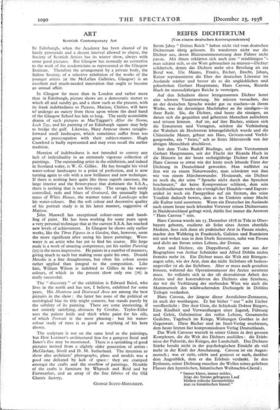ART
Scottish Contemporary Art IN Edinburgh, when the Academy has been cleared of its hardy perennials and a decent interval allowed to elapse, the Society of Scottish Artists has its winter show, always with some good pictures. But Glasgow has normally no corrective to the work of the academicians as represented at the Glasgow Institute. Therefore the arrangement by a private body, the Saltire Society, of a selective exhibition of the works of the younger artists (at the McLellan Galleries, Glasgow) is an excellent and much-needed innovation that ought to become an annual affair.
In Glasgow far more than in London and rather more than in Edinburgh, picture shows are a democratic matter to which all and sundry go, and a show such as the present, with its frank indebtedness to Picasso, Matisse, Chirico, will have to undergo an outcry from those upon whom the dead hand of the Glasgow School has lain so long. The easily assimilable drama of such pictures as MacTaggart's After the Storm, Loch Tay, and his painting of an Edinburgh square may help to bridge the gulf. Likewise, Mary Armour shows straight- forward small landscapes, which sometimes suffer from too great ,a preoccupation with their subject-matter. Hugh Crawford is badly represented and may even recall the earlier tradition.
Mention of indebtedness is not intended to convey any lack of individuality in an extremely vigorous collection of paintings. The outstanding artist in the exhibition, and indeed in Scotland today, is W. G. Gillies. He has brought his vivid water-colour landscapes to a point of perfection, and is now turning again to oils with a new brilliance and new technique. If there is nothing here quite like those superb canvases, the large interior and the flower-piece that dominate the S.S.A., there is nothing that is not first-rate. The savage, but easily controlled, reds and blues of Gruinard, the unusually high tones of White Houses, the warmer tones of 'Landscape echo his water-colours. But the soft colour and decorative quality of his portrait study is in his latest manner, suggestive of Matisse.
JOhn Maxwell has exceptional colour-sense and hand- ling Of paint. He has been working for some years upon a very personal technique that at the current S.S.A. has reached new levels of achievement. In Glasgow he shows only earlier works, like the Three Figures in a Garden, that, however, seem the more significant after seeing his latest paintings. West- water is an artist who has yet to find his course. His large nude is a work of amazing competence, yet his earlier Painting (25) is the more impressive. He paints in a number of manners, giving Much_to each but making none quite his own. Donald Moodie is a fine draughtsman, but often his colour seems rather applied than integral to the composition. Like hini, William Wilson is indebted to Gillies in his water- colour, of which in the present show only one (76) is really successful.
The " discovery " of the exhibition is Edward Baird, who lives in the north and has not, I believe, exhibited for some years. His Montrose and Distressed Area are among the best pictures in the show : the latter has none of the political or sociological bias its title might connote, but stands purely by the subtlety of its painting. There are some interesting, if not entirely satisfying, abstracts by Crosbie. Taylor-Elder uses the palette knife and thick white paint for his oils, of which Portrait is the most pleasing : but his water- colour study of trees is as good as anything of his here shown.
The sculpture is not on the same level as the paintings, but Hew Lorimer's architectural lion for a gatepost finial and Innes's Eve may be mentioned. There is a sprinkling of good pictures invited from a slightly older generation of artists : McGlashan, Sivell and D. M. Sutherland. The intention to show also architects' photographs, plans and models was a good one defeated by lack of space : they are cramped amongst the crafts and the overflow of paintings. Notable of the crafts is furniture by Whytock and. Reid and by Fairweather, and an array of the fine fabrics of the Old Glamis factory.
GEORGE SCOTT-MONCRIEFE.


































 Previous page
Previous page